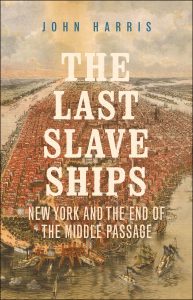Ricochet is the best place on the internet to discuss the issues of the day, either through commenting on posts or writing your own for our active and dynamic community in a fully moderated environment. In addition, the Ricochet Audio Network offers over 50 original podcasts with new episodes released every day.
 The New York-Based Slave Trade
The New York-Based Slave Trade

One of history’s curious episodes was a rise in transatlantic slave trading based in the United States in 1850 that continued through 1863. It occurred despite the abolition of the slave trade by Great Britain in 1807. The United States followed in 1808, with a long decline in illegal slave trading by US ships between 1808 and 1850.
“The Last Slave Ships: New York and the End of the Middle Passage,” by John Harris, tells the story of this resurgence in the slave trade, including the reasons behind it.
His tale is filled with unintended consequences. Harris shows, the revival occurred largely due to the abolition of slave importation to Brazil in 1850. Despite modern myths the vast majority Africans transported to the New World went to Spanish colonies (or former colonies) and Brazil.
England led the drive to shut down the slave trade, using its influence to force other European nations to ban the slave trade. It claimed the right to search ships suspected of carrying slaves, even those of foreign powers. The only nation exempted was the United States. Instead it sent a naval squadron to West Africa to enforce these rules.
Nations still permitting imported slaves dwindled through the first half of the nineteenth century, until only Brazil was left. Even the US banned importation of African slaves. (The Upper South, with a surplus of slaves allied with Free State Abolitionists to force the Deep South to purchase slave domestically.) With the Brazilian market gone, Cuba was the last remaining market. Even there importation was illegal. Cuba’s explosively expanding sugar industry kept the demand for slaves so high smuggling was winked at.
Harris tells how Portuguese and Brazilian slave traders relocated to New York City, establishing a new slave triangle: New York to Southwest Africa to Cuba). New York had everything they needed. The US’s biggest seaport, it was a city of immigrants, and the United States did not ban equipping ships as slaver. US flag ships could only be arrested carrying slaves. (Those of other nations could be seized for having slave decks and shackles.)
Harris tells a fascinating story. He shows how the trade grew, sheltered by US politics in the buildup to the Civil War, and funded by Free-State money. He traces the struggle, often underground, between the slavers and Great Britain. “The Last Slave Ships” is an interesting look at an odd corner of history.
“The Last Slave Ships: New York and the End of the Middle Passage,” by John Harris, Yale University Press, 2020, 312 pages, $30.00 (Hardcover), $14.99 (E-book), $18.37 (Audiobook)
This review was written by Mark Lardas who writes at Ricochet as Seawriter. Mark Lardas, an engineer, freelance writer, historian, and model-maker, lives in League City, TX. His website is marklardas.com.
Published in History



You review them faster than I can read them.
Well. I read fast. I write almost as fast as I read.
I do both faster than I can think – so there!